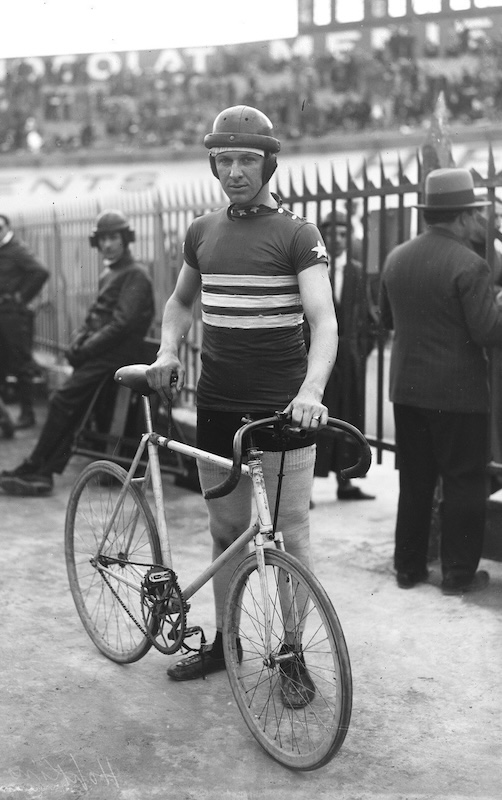July/Aug 2024 (Volume 16, Issue 4)
By Don Doxsie
Victor Hopkins’ son, Harry, frequently has said he thinks his father’s life story would make a great rags-to-riches movie script.
There is only one problem: Almost no one would believe it. Hardly anyone would find it plausible that an orphaned teenager scratching out a living doing assorted odd jobs in Eastern Iowa could suddenly evolve into one of the best cyclists in the world in the span of a year or so.
But that’s what Victor Hopkins did.

In a cycling career that extended from 1922 through 1934, Cedar Rapids native Victor Hopkins set a national record for five miles, competed in the 1924 Olympics and was a regular on the U.S. cycling circuit, winning the U.S. MotorPace championship in 1926. Photo courtesy of BNF Gallica
Hopkins, who grew up in Cedar Rapids and Davenport, became accomplished enough astride a bicycle that he was inducted into the United States Bicycling Hall of Fame in 2006, seven decades after achieving his greatest glories.
All of it came about because of a chance meeting on the streets of Davenport when Hopkins was only 17 years old.
Hopkins was born on July 19, 1904, in Cedar Rapids, to an unwed mother. The myth through the years, perpetuated by Hopkins himself, was that she was a circus performer, but she actually was just an impoverished Irish immigrant girl named Mary McGarvey, who was listed in the adoption papers as Mary Morice.
Her baby was put up for adoption and when he was not quite a year old, he was placed with Jacob and Catherine Hopkins of Cedar Rapids. Jacob worked as a hay broker and had a sometimes combustible, often dysfunctional relationship with his wife and daughter, which created an uneasy atmosphere for his adopted son. Catherine died in 1912 and when Jacob was killed in a hay wagon mishap early in 1914, it left nine-year-old Victor without a home or any means of support.
He eventually was sent to the Iowa Soldiers’ Orphans’ Home in Davenport, a facility that still stands today as the Annie Wittenmyer Center. Hopkins lived there for several years but at the age of 16, he ventured out on his own and made ends meet in a variety of ways. He began working as a farm laborer while still in the orphanage, did some work as a tailor and breezed through the streets of Davenport on a bicycle, delivering newspapers and Western Union messages.
That’s what he was doing when he was spotted by a man named Worthington Longfellow Mitten.
Mitten was the leader of the Davenport Bicycle Club and he wondered if Hopkins might be interested in joining the club. Mitten was no small-time cycling enthusiast. He had been one of the best riders in the country a decade earlier, and he and his club members regularly traversed an 85-mile circuit from Davenport, to DeWitt, to Clinton, and back to Davenport. He trained some of the top riders in the Midwest and later designed and manufactured bicycles that were used by some of the best riders in the country.
Under Mitten’s tutelage, Hopkins almost immediately became the swiftest rider in the club. Within a year after taking up the sport, he broke the amateur world record for five miles at age 17 in 1922, covering the distance in 11 minutes, 22 seconds. Two years after that, Hopkins was competing in the 1924 Olympic games in Paris as the America’s No. 1 road racer. In 1926, he won the U.S. MotorPace championship for that style of cycling. For a time in the late 1920s, he was one of the highest paid athletes in the country, earning as much in a week as he ever did in a year pedaling for Western Union.
TO READ THE ENTIRE STORY AND OTHER FASCINATING STORIES ABOUT IOWA HISTORY, subscribe to Iowa History Journal.
